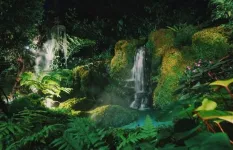Hospital wastewater favors multi-resistant bacteria
2021-02-16
(Press-News.org) Scientists from the University of Gothenburg, Sweden presents evidence that hospital wastewater, containing elevated levels of antibiotics, rapidly kills antibiotic-sensitive bacteria, while multi-resistant bacteria continue to grow. Hospital sewers may therefore provide conditions that promote the evolution of new forms of antibiotic resistance.
It is hardly news that hospital wastewater contains antibiotics from patients. It has been assumed that hospital sewers could be a place where multi-resistant bacteria develop and thrive due to continuous low-level antibiotic exposure. However, direct evidence for selection of resistant bacteria from this type of wastewater has been lacking, until now.
A research group at the University of Gothenburg, Sweden, led by Professor Joakim Larsson, has sampled wastewater from Sahlgrenska University Hospital in Gothenburg, and at the inlet and outlet of the local municipal treatment plant for comparison. They first removed all bacteria from the wastewaters by filtering and tested how the filtered wastewater affected bacteria in different controlled test systems in the lab.
"The results were very clear," says Joakim Larsson. "In all assay, we could see that antibiotic-sensitive bacteria were rapidly killed by the hospital wastewater, while the multi-resistant ones continued to grow. The wastewater entering the municipal treatment plant, primarily made up of wastewater from households, showed a very slight effect, while we could not see any effect of the filtered wastewater."
"It is good news that the wastewater entering the Göta Älv river is not selecting for resistant bacteria, but the strong selection by hospital wastewater is concerning," says Larsson. "Strong selection pressure that favors multi-resistant bacteria is the most important driver behind the evolution of new forms of resistance in pathogens. We now know that hospital wastewater does not only contain pathogens, it can also favor resistant bacteria."
Sweden uses very little antibiotics compared to many other countries in the world. It is therefore plausible that hospitals wastewaters from other places in the world also favor resistant bacteria, but this remains to be investigated. The researchers found some antibiotics that could explain some of the effects on bacteria, but they say that more research is needed to clarify exactly what is favoring the multi-resistant ones.
"One possible way to reduce risks could involve pre-treatment of wastewater at hospitals, something that is done in certain countries already", explains Larsson. "To find the best ways to reduce risks, including designing possible treatment measures, it is critical to first figure out which antibiotics or other antibacterial chemicals explain selection for resistance. That is something we are working on right now."
INFORMATION:
The study has been published in the scientific journal Environment International.
Kraupner N, Hutinel M, Schumacher K, Gray DA, Genheden M, Fick J, Flach C-F, Larsson DGJ. (2021). Evidence for selection of multi-resistant E. coli by hospital effluent. Environment International 150:106436 https://www.sciencedirect.com/science/article/pii/S0160412021000611
Contact: For more information, please contact Joakim Larsson, preferably by email first: joakim.larsson@fysiologi.gu.se
Research team: Research interests - Joakim Larsson group; https://www.gu.se/en/biomedicine/about-us/department-of-infectious-diseases/joakim-larsson-group
CARe: Centre for Antibiotic Resistance Research; https://www.gu.se/en/care
[Attachments] See images for this press release:

ELSE PRESS RELEASES FROM THIS DATE:
2021-02-16
A polymer that is custom designed to produce light that penetrates murky environments has shown promise in bioimaging trials, where it can detect nano-sized particles underneath the surface of realistic tissue models.
Recent studies have demonstrated that fluorescent probes -- light-emitting materials that attach to tiny targets such as cells -- are particularly useful for bioimaging when they radiate in the shortwave infrared (SWIR) region of the optical spectrum. Because this type of fluorescent light penetrates deeper into biological objects without being absorbed or scattered, SWIR ...
2021-02-16
Humans inhabit an incredible range of environments across the globe, from arid deserts to frozen tundra, tropical rainforests, and some of the highest peaks on Earth. Indigenous populations that have lived in these extreme environments for thousands of years have adapted to confront the unique challenges that they present. Approximately 2% of people worldwide live permanently at high altitudes of over 2,500 meters (1.5 miles), where oxygen is sparse, UV radiation is high, and temperatures are low. Native Andeans, Tibetans, Mongolians, and Ethiopians exhibit adaptations that improve their ability to survive such conditions. Andeans, for example, display increased chest circumference, elevated oxygen saturation, and a low hypoxic ventilatory response, enabling them to thrive at exceptionally ...
2021-02-16
New study from Warwick Medical School examined the effectiveness of three alternatives to CPR, concluding that none were beneficial
First comprehensive systematic review of evidence on precordial thump, percussion pacing and cough CPR - all of which have fallen out of routine practice
Precordial thump is often portrayed in television and film, and cough CPR misinformation circulates frequently on social media - but neither are effective
Reaffirms CPR as the 'gold standard' technique when assisting someone experiencing a cardiac arrest
A technique frequently portrayed in dramatic resuscitation scenes in television ...
2021-02-16
Scientists created a framework to test the predictions of biological optimality theories, including evolution.
Evolution adapts and optimizes organisms to their ecological niche. This could be used to predict how an organism evolves, but how can such predictions be rigorously tested? The Biophysics and Computational Neuroscience group led by professor Gašper Tkačik at the Institute of Science and Technology (IST) Austria has now created a mathematical framework to do exactly that.
Evolutionary adaptation often finds clever solutions to challenges posed by different environments, from how to survive in the dark depths of the oceans to creating intricate organs such as an eye or an ear. But can we mathematically predict these outcomes?
This is ...
2021-02-16
Fossilised remains of a fish that grew as big as a great white shark and the largest of its type ever found have been discovered by accident.
The new discovery by scientists from the University of Portsmouth is a species of the so-called 'living fossil' coelacanths which still swim in the seas, surviving the extinction that killed off the dinosaurs.
The discovery was purely serendipitous. Professor David Martill, a palaeontologist from the University's School of the Environment, Geography and Geosciences, had been asked to identify a large ...
2021-02-16
In plants, the "meristem" refers to a type of tissue comprising undifferentiated cells from which various other plant organs can develop through cell division and differentiation. These "plant stem cells" give rise to shoots, leaves and roots, but also spikes and flowers.
The research team including members of the Cluster of Excellence on Plant Sciences CEPLAS investigated the function of a gene responsible for the different spike forms of wheat and barley. This gene controls the activity of the spike and floret meristems and thus the number of spikelet ...
2021-02-16
The research team that developed a biosensor that first recorded that a distinct gradient of the plant growth hormone gibberellin correlated with plant cell size has now revealed how this distribution pattern is created in roots.
Starting when a plant embryo forms within a seed and continuing throughout the plant lifecycle, undifferentiated stem cells undergo radical transformations into specialised root, stem, leaf and reproductive organ cells. This transformation relies on a suite of molecules called phytohormones that, much like human hormones, can move between cells and tissues and trigger distinct biological processes across the bodyplan. While it was not known at the time, mutations involving the gibberellin class of ...
2021-02-16
PITTSBURGH, Feb. 15, 2021 - Why do patients who receive antipsychotic medications to manage schizophrenia and bipolar disorder quickly gain weight and develop prediabetes and hyperinsulemia? The question remained a mystery for decades, but in a paper published today in Translational Psychiatry, researchers from the University of Pittsburgh School of Medicine finally cracked the enigma.
Antipsychotic drugs, scientists showed, not only block dopamine signaling in the brain but also in the pancreas, leading to uncontrolled production of blood glucose-regulating hormones and, eventually, obesity and diabetes.
"There are dopamine theories of schizophrenia, drug addiction, depression and neurodegenerative disorders, and we are presenting a dopamine theory of metabolism," said lead ...
2021-02-16
For more than a decade, governments in countries across the world have made significant progress to expand their protected areas network to conserve the planet's biodiversity. According to a new study published in the journal Global Change Biology, the locations of these protected areas do not take into account the potential long-term effects of climate change in these protected areas.
Creating and managing protected areas, such as national parks, is key for biodiversity conservation. As the climate changes, however, species will disperse in order to maintain their specific habitat needs. Species that were in protected areas ...
2021-02-16
Almost half the patients admitted to an intensive care unit (ICU) require invasive mechanical ventilation (IMV), a medical procedure that guarantees a sufficient supply of oxygen to their organs and tissues. The therapy involves connecting patients to a machine that substitutes their spontaneous breathing. In recent months it has been in general use in intensive-care patients affected by COVID-19.
Although it can often save a patient's life, invasive mechanical ventilation is not risk-free: there can be accidental injury during intubation or extubation or the muscles ...
LAST 30 PRESS RELEASES:
[Press-News.org] Hospital wastewater favors multi-resistant bacteria







